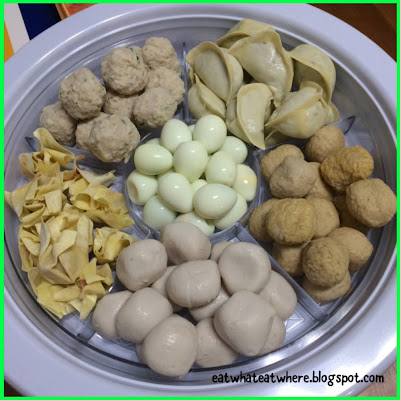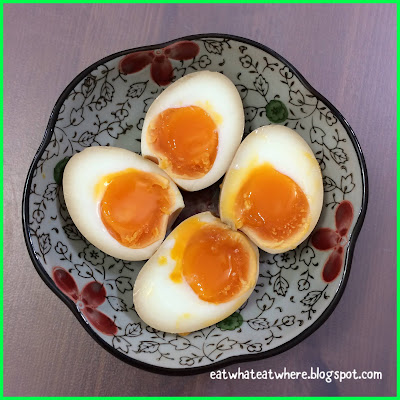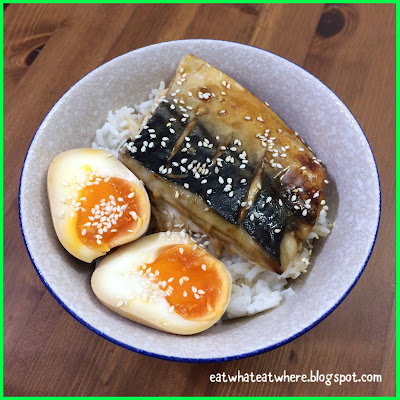Ever since dining in was allowed again during this period of Conditional MCO, I've still not been able to dine at some of my favourite shops.....and that's because some of these places (I'm referring more to stalls in coffee shops) are highly popular. I have to be selective (for now) as to which shops I can or should dine in as it would mean sharing a table with strangers more often than not. As these places (with good food) are perpetually crowded, finding a table to ourselves is almost impossible unless we're willing to wait...and, even then, there's no guarantee you'll get a table to yourself.
And it was because of this very reason of not being able to eat my favourite prawn mee that I had to look for other alternatives which brought us to San Peng Prawn Mee @ Jalan San Peng one weekend morning.
This one happens to be located just next to my favourite kai see hor fun. I've heard of this prawn mee before but have never felt the need to try since I already had my go-to one. Well, this is a typical roadside hawker stall, so get ready for minimal cleanliness and comfort in terms of eating environment.
We both ordered the usual bowl of Prawn Mee @ RM9 which came with the usual trappings of prawns, kangkung, beansprouts, fried shallots and chilli paste (but no thinly sliced pork or hard-boiled egg).
Except this bowl of prawn mee isn't quite the traditional bowl of prawn me as it came with an unusual accompaniment of poached chicken (instead of lean pork slices) which the lady boss did allude us at the time of ordering.
As for the prawn stock, there seemed to be an adequate amount of prawn oil swimming around the bowl but the soup base tasted a bit diluted to me and lacked sufficient prawn aroma in the stock. Well, at least the fried shallots were freshly fried in-house (and not the straight-out-of-a-packet kind). You can add on chilli paste (which is free flow...until they take away the bowl of sambal) to spice up your soup base even more although it's already quite spicy without any addition.
Nothing to fault the medium-sized prawns as they were fresh and sweet tasting but don't get so excited first when you see 5 - 6 prawns in your bowl of prawn mee when served.
Coz the prawns turned out to have been halved lengthwise! :O Haiz, that means you only get half the amount of prawns! >_<
You can also order a more premium bowl with larger prawns which will cost at least double (RM22 was the price I saw stated in a 2021 blogpost). I did see some bowls of that whizzing past me (with 2 or 3 shell-on large prawns sticking out from the bowl) but I'd want to know how the taste stacks up first before attempting a more luxurious (aka expensive) version, of course.
Since there's the non-traditional ingredient of poached chicken in their prawn mee, I gather it must be a speciality of theirs, so I ordered a separate plate of Poached Chicken @ RM9 (I asked for the thigh portion) to savour it in its true form.
The poached chicken was served on top of some crunchy beansprouts and they were tender and certainly decent but not quite the standard of the smooth and tasty poached chicken of their kai see hor fun neighbour. The soy sauce served with the chicken was not in the same league of deliciousness either as their neighbour's...it had a more pronounced flavour of sesame oil which can be a little overpowering if you're not a fan of sesame oil. There weren't (or, at least, we weren't given) any fresh chilli dip for the chicken too.
My Personal Opinion
Neither the prawn mee nor the poached chicken wowed us. Worst still was that my husband saw (after our meal) something that was best left unseen (with regards to their food prep). I won't go into the details of that but let's just say that when your stall is set up in such a way that your diners have full view of your prep area, you should be alerted to the fact that what you do is open for all to see. >_< Of course such deplorable acts may also occur in other food stalls...but (at least) what we don't see, we won't feel disgusted.
Well, it looks like I won't be needing to come back to try the more luxurious version with big prawns now. More so when we saw something we didn't need to see.....and let's leave it at that! O_o
San Peng Prawn Mee
823/15 Jalan Susur
Off Jalan San Peng
Pudu
55200 Kuala Lumpur






























































